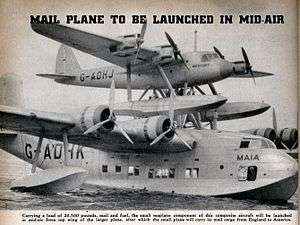Piggyback (transportation)
.jpg)
Piggyback transportation refers to the transportation of goods where one transportation unit is carried on the back of something else. It is a specialised form of intermodal transportation and combined transport.[1]
Etymology
Piggyback is a corruption of pickaback, which is likely a folk etymology alteration of pick pack (1560s), which perhaps is from pick, a dialectal variant of the verb pitch.[2]
Examples
Rail
_(6265367138).jpg)

In rail transport, the practice of carrying trailers or semi-trailers in a train atop a flatcar is referred to as "piggybacking".[3] Early drawings of the Liverpool and Manchester Railway c1830 show road coaches being piggybacked on railway flat wagons. [4]
The rail service provided for trucks which are carried on trains for part of their journey is referred to as a rolling road, or rolling highway. A related transportation method is the rail transport of semi-trailers, without road tractors, sometimes referred to as "trailer on flatcar" (TOFC).
It is also possible to carry a railway wagon of one track gauge on a flat railway wagon (transporter wagon or rollbock) of another gauge; indeed, whole trains of one gauge can be carried on a train of flat wagons of another gauge, as was done in Australia for about a year around 1955 between Telford and Port Augusta.[5][6]
The loading of semi-trailers in the United States grew from 1% of freight in 1957 to 15% in 1986.[7]
In South Australia, rolling stock is transferred to and from the isolated Eyre Peninsular Railway from Whyalla to Port Lincoln on road trailers. [8] A change in the gauge of the bogies is carried out at the same time.
Marine
Small ships of all kinds can be piggybacked on larger ships. Examples include lifeboats, landing craft, and minesweepers on motherships,[9] as well as Midget submarines on larger submarines, such as those used for the 1942 Japanese submarine attack on Sydney.
Air transport
The 1930s British Short Mayo Composite, in which a smaller, four-engined floatplane aircraft named Mercury was carried aloft on the back of a larger four-engined flying boat named Maia, enabled the Mercury to achieve a greater range than would have been possible had it taken off under its own power. In space transportation systems, a smaller satellite that is carried as a secondary payload on a launch is said to be "piggybacked" on the main launch.
The American Space Shuttle was carried on top of specially-modified Boeing 747 Shuttle Carrier Aircraft when the shuttle landed at places other than Kennedy Space Center.
Military
The metal caterpillar treads of a tank wear out quickly when travelling long distances on ordinary roads. It is therefore necessary to provide tank transporters, which have rubber tires, to the battlefield.
Gallery
|
See also
- Autorack
- Double-stack rail transport
- Motorail
- Fireman's carry
- Bière–Apples–Morges Railway
- Pichi Richi Railway
- Konkan Railway Corporation
- Roll-on/roll-off
- Two-foot-gauge railways in South Africa
References
- ↑ Pearlman, Robert Z. (7 September 2012). "Shuttle Endeavour to get one last piggyback ride across US". MSNBC. Retrieved 24 October 2012.
- ↑ Harper, Douglas. "piggyback". Online Etymology Dictionary. Retrieved 24 October 2012.
- ↑ THE GEOGRAPHY OF TRANSPORT SYSTEMS
- ↑ "The Train Book" by DK, p23
- ↑ Trove - Pick-a-back operation solves gauge-break problem, 1955 / Adelaide Advertiser
- ↑ Uniform Eailway Gauge, E. Harding, Lothian Publishing Co., 1958
- ↑ Field, Alexander J. (2011). A Great Leap Forward: 1930s Depression and U.S. Economic Growth. New Haven, London: Yale University Press. p. 114. ISBN 978-0-300-15109-1.
- ↑ Railway locomotive loaded onto road semi-trailer.
- ↑ "Mine-Sweepers By "Piggyback"", The Mercury (Hobart): 5, 5 June 1951
External links
| Look up piggyback in Wiktionary, the free dictionary. |
| Wikimedia Commons has media related to Piggy-back transport. |



